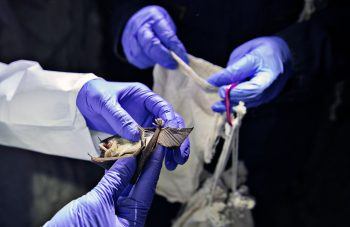Jim Robbins in The New York Times:
 ELY, Nev. — A crew of five wildlife biologists wearing overalls, helmets and headlamps walked up the flanks of a juniper-studded mountain and climbed through stout steel bars to enter an abandoned mine that serves as a bat hibernaculum.
ELY, Nev. — A crew of five wildlife biologists wearing overalls, helmets and headlamps walked up the flanks of a juniper-studded mountain and climbed through stout steel bars to enter an abandoned mine that serves as a bat hibernaculum.
The swinging white light of the headlamps probed cracks and crevices in the walls of the long dark and narrow tunnel, as the team walked half a mile into the earth. When they spied a bat, they gently plucked the mouse-sized, chestnut brown mammal — Townsend’s long eared and Western small footed are the two most abundant species here — off the walls and deposited them in white cloth bags. A lone big brown bat was also gathered. At one point a bat, disturbed by the scientific ruckus, fluttered by, the headlamps illuminating its membranous, négligée-thin wings. During the survey in November, the bats were in their pre-hibernation phase, clinging to the gray rock wall with tiny grappling hook-like feet, gently breathing. They are in full hibernation mode now. “They are biologically interesting,” said Catherine G. Haase, a postdoctoral researcher from Montana State University, as she affectionately handled a docile bat. “And they are really cute.”
Cute, interesting and facing a deeply uncertain future. This foray is part of a continentwide effort, from Canada to Oklahoma, to plumb mines and caves in hopes of figuring out how a virulent and rapidly spreading invasive fungal bat disease called white-nose syndrome, which is bearing down on the West, will behave when it hits the native populations here. “White-nose syndrome represents one of the most consequential wildlife diseases of modern times,” wrote the authors of one recent paper published in mSphere, a journal of the American Society for Microbiology. Since 2006, “the disease has killed millions of bats and threatens several formerly abundant species with extirpation or extinction.” White-nose syndrome, caused by the fungus Pseudogymnoascus destructans (Pd), is named for the fuzzy spots that appear on bats’ noses and wings.
More here.
